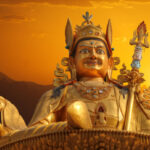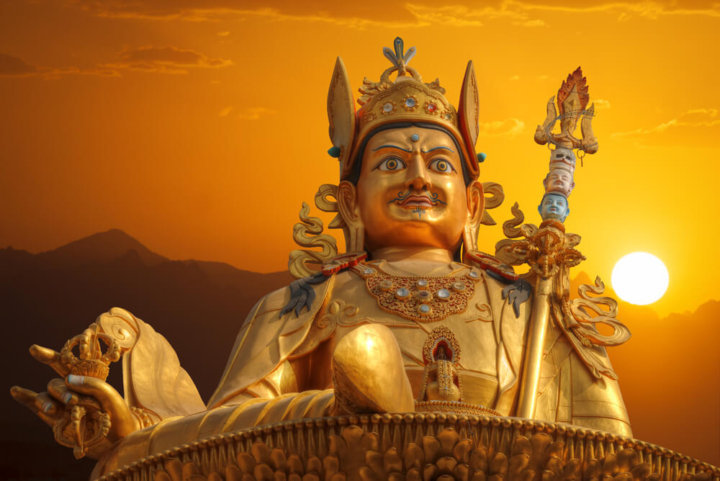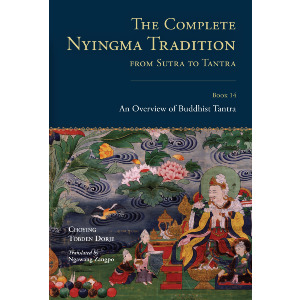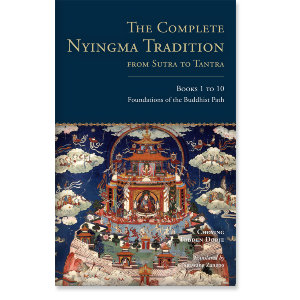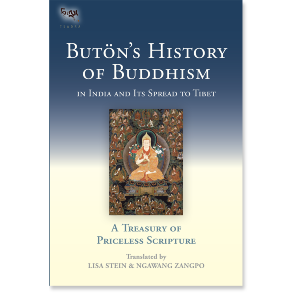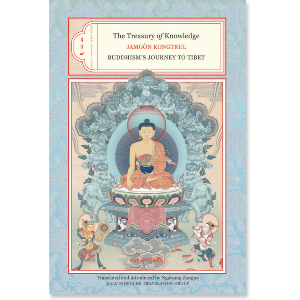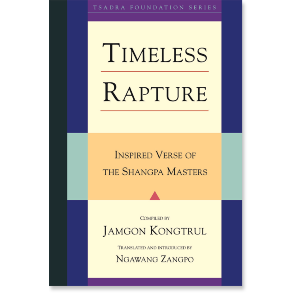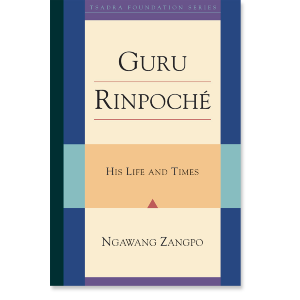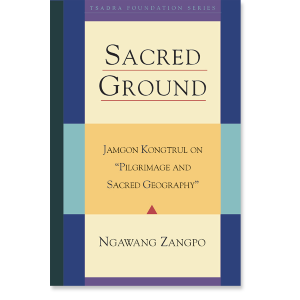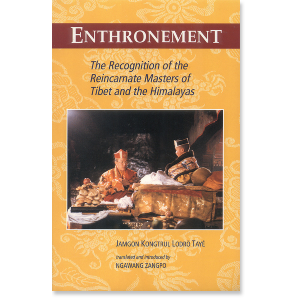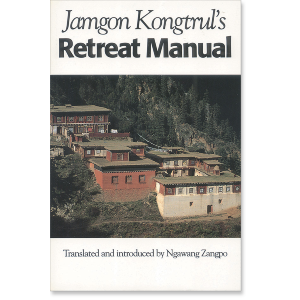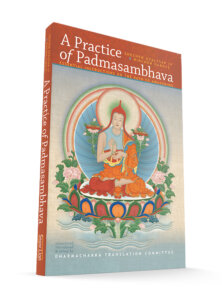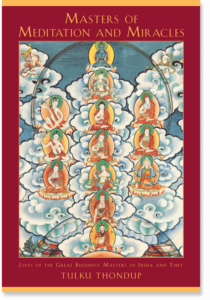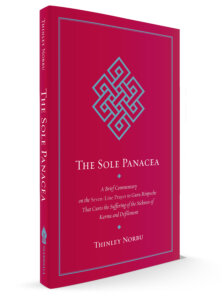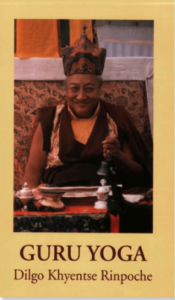| The following article is from the Spring, 2002 issue of the Snow Lion Newsletter and is for historical reference only. You can see this in context of the original newsletter here. |
See also our Reader's Guide to Guru Rinpoche Padmasmbhava with a full list of resources.
Guru Rinpoche: His Life and Times
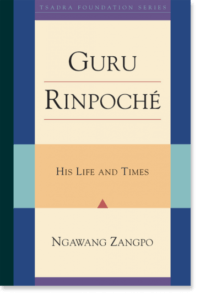
by Ngawang Zangpo
About this Book
To Tibetan Buddhists Guru Rinpoche is a Buddha. In 763, Tibet's powerful armies overran the capital of China and installed a puppet emperor. Why didn't Tibet continue its aggressive military campaigns? This transformation was due to Guru Rinpoche who tamed and converted Tibet to Buddhism and thereby changed the course of Asian history.
This book recounts Guru Rinpoche's historical visit to Tibet and explains his continuing significance to Buddhists. Four very different Tibetan accounts of his story are presented:
Buddhist accounts:
A Biography of Guru Rinpoche by Jamgon Kongtrul
The Immaculate While Lotus by Yeshe Tsogyal
One according to the pre-Buddhist Tibetan religion, Bon:
The Bon Version of the Life of Guru Rinpoche by Jamyang Khyentse Wangpo
One based on Indian and early Tibetan historical documents:
The Indian Version of the Life of Guru Rinpoche by Taranata.
In addition, there are supplications by Guru Rinpoche and visualizations to accompany them by Jamgon Kongtrul.
Praise for Guru Rinpoche: His Life and Times
"The presence of Guru Rinpoche, a figure so important to Tibetan Buddhists he is called simply 'The Precious Master', can be felt still in each of these liberating stories translated here. Read side-by-side, they reveal an even wider picture, deftly highlighted by Ngawang Zangpo's introduction, of how history and culture interact with the inner spirituality that is beyond time and place."— Sarah Harding, author of Creation and Completion
"With a thought-provoking introduction and stimulating cultural, religious, and literary insights, Ngawang Zangpo offers welcome translations of four biographies of Gum Rinpoche and a set of famous supplications. This new work will certainly be enjoyed by everyone interested in the vast spiritual legacy of the Second Buddha' in Tibet." —Cyrus Stearns, author of Buddha from Dolpo
Ngawang Zangpo (Hugh Thompson) lives near Santa Cruz, California. His previous works include Sacred Ground: Jamgon Kongtrul on Pilgrimage and Sacred Geography.
Persons who cannot force themselves to board an airplane cannot fly; people who cannot accept a relationship based on faith and devotion cannot practice tantra.
Excerpt From Guru Rinpoche: His Life and Times
Non-Tibetans can now meet Guru Rinpoche, but the encounter can only be meaningful with faith. Our faith and devotion provide the only access possible to the timeless, ever-present Guru Rinpoche, and this faith and devotion must begin in relation to a human spiritual master and a lineage. For some people this is an impossible task, which should not be a problem unless they imagine they want to practice tantra. Persons who cannot force themselves to board an airplane cannot fly; people who cannot accept a relationship based on faith and devotion cannot practice tantra. Dzongsar Jamyang Khyentse Rinpoche writes in the same book:
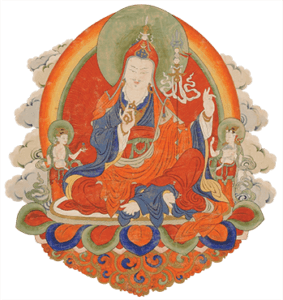
The purpose of Dharma practice is to attain enlightenment. Actually, attaining enlightenment is exactly the same as ridding ourselves of ignorance, and the root of ignorance is the ego. Whichever path we take, whether it's the long and disciplined route, or the short and wild one, at the end of it the essential point is that we eliminate ego.
There are many, many different ways we can do this, for example through Shamatha [tranquility] meditation, and they all work to one extent or another. However, since we have been with our ego for so many lifetimes and we are so familiar with it, every time we take to a path in our efforts to eliminate ego, that very path is hijacked by ego and manipulated in such a way that rather than crushing our ego, our path only helps to reinforce it.
That is the reason why, in the Vajrayana, guru devotion, or Guru Yoga, is taught as a vital and essential practice. As the guru is a living, breathing human being, he or she is able to deal directly with your ego. Reading a book about how to eliminate ego may be interesting, but you will never be in awe of a book, and anyway, books are entirely open to your interpretation. A book cannot talk or react to you, whereas the guru can and will stir up your ego so that eventually it will be eliminated altogether. Whether this is achieved wrathfully or gently doesn't matter, but in the end this is what the guru is there to do, and this is why guru devotion is so important.
I believe that all tantric Buddhists should be as frank as this master about their path and what sets it apart from the other Buddhist paths: faith and devotion to the spiritual master. In Sanskrit they say, "Guru Yoga;" in English we might say, "communion with the spiritual master's mind." Tantra takes pride in its plethora of practices: it aims to answer everyone's needs with easy, accessible, and efficient ways to enlightenment. Yet every single one of those skillful means depends on the spiritual master, a human being from whom we receive transmission of empowerment, the lineage, and guidance; and, after we receive instruction, our success or failure depends not on our diligence, not on our goodness, and not on our intelligence, but on our faith and devotion to our spiritual master.
Tantra cannot be all things to all people. Some of us have serious issues with a relationship grounded in the intense devotion tantra demands. It is in no way a judgment of those individuals or of tantra to say that they were not made for one another. Tantra is not to everyone's taste, nor can it ever be made to be.
"...attaining enlightenment is exactly the same as ridding ourselves of I ignorance, and the root of ignorance is the ego. Whichever path we take, whether it's the long and disciplined route, or the short and wild one, at the end of it the essential point is that we eliminate ego."
Guru Rinpoche is for most Himalayan Buddhists the second Buddha, the Buddha of every form and teaching of enlightenment, with an accent on the tantras. Just as the Great Way teaches us to identify our enlightened nature and call it buddha-nature, tantra teaches us to first see our teachers as Guru Rinpoche. Then we see all phenomena as Guru Rinpoche, down to every atom of our own body, every atom of all beings equally, and every atom of every blade of grass, every grain of sand. Finally, when we recognize our own innate, timeless awareness, it as well is none other than Guru Rinpoche.
Dzongsar Jamyang Khyentse Rinpoche writes:
The first stage of guru devotion, then, is to awaken and enhance our devotion, until it becomes sound and strong and we can actually look upon the guru as the Buddha.
Gradually we will reach the second stage, where we don't simply think the guru is the Buddha, we see he is the Buddha. As our devotion becomes stronger still, it is with a growing sense of joy that we begin to rely entirely on the guru for everything. An inner confidence arises, an absolute certainty that the guru is the only source of refuge. No longer do we have to create or fabricate our devotion now it comes quite naturally.
Then, all our experiences, good or bad, are manifestations of the guru. Everything we experience in life becomes beneficial and has a purpose; everything we encounter becomes a teaching. Total trust and devotion for the guru is born within our heart, and the blessing of the guru dissolves into our mind.
With this, we reach the third stage, which is when we realize that our mind is none other than the guru whom we have seen as the Buddha.
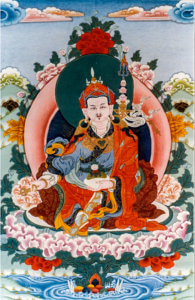
This Guru Rinpoche, while timeless, is introduced to us thanks to a lineage of masters who have passed on their wisdom in an uninterrupted stream to the present. In the preface to Masters of Meditation and Miracles, Tulku Thondup makes a statement that should be repeated in every Tibetan translation:
It was improper and indeed impossible for me to try to avoid the typical characteristic of Tibetan biographies, namely the inclusion of endless lists of teachers, teachings, and disciples of the masters, even though those lists might be boring for readers who are not Tibetan.
He then traces the lineages from Guru Rinpoche and other great masters down to the present, each an essential link. Each deserves to be honored by our attention. How many of us learned (or still learn?) the names of members of sports teams, or of rock bands, or of political parties, during their fleeting moments of fame and fortune? We definitely have the capacity to learn the names and personal histories of the enlightened individuals who have contributed to the wisdom bridge that reaches us.
The members of lineages from Guru Rinpoche should not be faceless, nameless persons: they have kept real and alive what is most important to us the full presence and blessing of Guru Rinpoche.
Lineages of wisdom have been compared to electricity that flows from a power plant to one's home: If the flow is interrupted or faulty at any point, the flow of electricity will stop. The members of lineages from Guru Rinpoche should not be faceless, nameless persons: they have kept real and alive what is most important to us the full presence and blessing of Guru Rinpoche. Different masters reflect the needs of their time on a superficial level, and thus might seem foreign to us, but the wisdom-electricity we receive from our teachers has passed through them and, thanks to them, is exactly the same as it was a thousand years ago.
Guru Rinpoche first appeared as an Indian, a guise that caused his expulsion from Tibet. Yet, with some more reflection over time, Tibetans came to worship Indian spirituality and Indian masters. To the present day, the focus of Tibetan Buddhism remains fixed not upon indigenous Tibetan masters, however impressive they were, but upon non-Tibetans, Buddha Shakyamuni and Guru Rinpoche.
These days, Guru Rinpoche first appeared to us primarily in a Tibetan guise. The Tibetan masters' priceless gift to us has been to introduce foreigners worldwide to Guru Rinpoche's timeless wisdom in such ways as to make it comprehensible, attractive, and accessible. They have had to confront in their new students many non-conducive attitudes, such as distrust, self-seriousness and solemnity, but they disarmed and relaxed us with their light humor, gentle warmth, and sincere concern (or love, to be more precise). Not only did they bring Guru Rinpoche into our lives, they made it seem that the most natural, clear-headed, and light-hearted thing to do is to discover eternal Guru Rinpoche within ourselves. What we saw as insurmountably distant proved to be innate, and what intimidated us proved to be child's play.
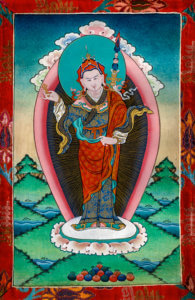
What we saw as insurmountably distant proved to be innate, and what intimidated us proved to be child's play.
Modern spiritual masters of all races now bring Guru Rinpoche to our level, but that is not to say that it would not be wise for us, on our part, to rise to the occasion. If you feel the urge to do yourself an enormous favor, attend any lecture by the Dalai Lama (or so many other tantric masters I could name) when he visits your continent. Or plunge into Journey to Enlightenment, Matthieu Ricard's book on the life of Dilgo Kyentse Rinpoche.
These masters, who introduce us so surely and gently to what has always been our nature, making it seem so familiar and close, provide living proof of the wondrous qualities of that same nature's manifest expression, which surpass all measure and understanding.
Who are these unfathomable beings if they are not Guru Rinpoche?
I cite them because they are persons of living memory, whom we can meet in person or in photographs or in words spoken directly in English, and I mention them because, they present us with a paradox. On the one hand, our recognition of our inner nature must accompany us on a "kitchen-sink level," as Trungpa Rinpoche used to remind us, and yet our inner Guru Rinpoche's positive qualities are what, we call, for lack of better words, inconceivable and inexpressible. These masters, who introduce us so surely and gently to what has always been our nature, making it seem so familiar and close, provide living proof of the wondrous qualities of that same nature's manifest expression, which surpass all measure and understanding.
Ngawang Zangpo (Hugh Leslie Thompson) completed two three-year retreats under the direction of the late Kalu Rinpoche. He is presently working on a number of translation projects that were initiated under the direction of Chadral Rinpoche and Lama Tharchin Rinpoche. He has also contributed to Kalu Rinpoche's translation group's books Myriad Worlds and Buddhist Ethics.
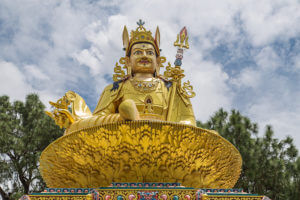
Padmasambhava (eighth century), the Indian meditation master, is the founder of the Nyingma tradition, the oldest Buddhist tradition in Tibet. In addition to introducing the practices of tantric Buddhism to Tibet, he also completed the building of Samye, the first Buddhist monastery in Tibet.

